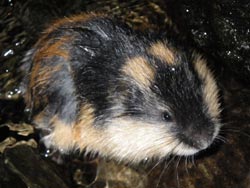Will changes in climate wipe out mammals in Arctic and sub-Arctic areas?

Caption: The lemming is a species that will decline if the climate changes in the way climatologists predict. This lemming is a bit wet following a swim in the Vindel River. Photo: Christer Nilsson<br>
The scientists Anouschka Hof, Roland Jansson, and Christer Nilsson of the Department of Ecology and Environmental Science at Umeå University investigated how future climate changes may come to impact mammals in northern Europe’s Arctic and sub-Arctic land areas, excluding the Arctic seas and islands. These land masses are assumed to undergo major changes in climate, and their natural ecology is also regarded as especially susceptible to changes.
By modeling the distribution of species, the researchers have determined that the predicted climate changes up to the year 2080 will benefit most mammals that live in these areas today, with the exception of some specialists in cold climate, such as the Arctic fox and the lemming.
“This will be the case only on the condition that the species can reach the areas that take on the climate these animals are adapted to. We maintain that it is highly improbable that all mammals will be able to do so, owing partly to the increased fragmentation of their living environments caused by human beings. Such species will reduce the extent of their distribution instead,” says Christer Nilsson, professor of landscape ecology.
The researchers also show that even if climate changes as such do not threaten the majority of Arctic and sub-Arctic mammals, changes in the species mix may do so, for instance because predators and their potential prey that previously did not live together may wind up in the same areas.
The study was carried out with support from the Nordic Council of Ministers. The work was recently published in the journal Plos ONE.
Original publication:
Title: Future Climate Change Will Favour Non-Specialist Mammals in the (Sub)Arctics
Journal: Plos ONE
Authors: Anouschka R. Hof, Roland Jansson, and Christer Nilsson, Regional Ecology, Department of Ecology and Environmental Science, Umeå University
For more information, please contact:
Dr. Anouschka Hof at the Department of Ecology and Environmental Science
Telephone: 090-786 63 77
E-mail: anouschka.hof@emg.umu.se
Media Contact
All latest news from the category: Ecology, The Environment and Conservation
This complex theme deals primarily with interactions between organisms and the environmental factors that impact them, but to a greater extent between individual inanimate environmental factors.
innovations-report offers informative reports and articles on topics such as climate protection, landscape conservation, ecological systems, wildlife and nature parks and ecosystem efficiency and balance.
Newest articles

Superradiant atoms could push the boundaries of how precisely time can be measured
Superradiant atoms can help us measure time more precisely than ever. In a new study, researchers from the University of Copenhagen present a new method for measuring the time interval,…

Ion thermoelectric conversion devices for near room temperature
The electrode sheet of the thermoelectric device consists of ionic hydrogel, which is sandwiched between the electrodes to form, and the Prussian blue on the electrode undergoes a redox reaction…

Zap Energy achieves 37-million-degree temperatures in a compact device
New publication reports record electron temperatures for a small-scale, sheared-flow-stabilized Z-pinch fusion device. In the nine decades since humans first produced fusion reactions, only a few fusion technologies have demonstrated…





















